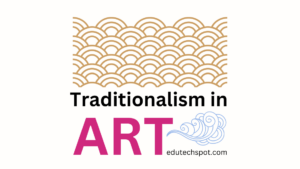In the vast world of digital art, finding inspiration is essential for artists of all levels. We’ve compiled a list of 50 digital art ideas to help you unlock your creativity:
Check our list of Digital Art Websites
Digital Art Ideas for Beginners
Digital Art Ideas for Beginners: Initiating your artistic journey with beginner-friendly concepts is an excellent way to make digital art accessible to all, especially if you’re just starting out. These ideas provide a solid foundation and encourage experimentation, setting you on the path to becoming a proficient digital artist.
Characteristics: Beginner-friendly digital art ideas often encompass simplicity, straightforward techniques, and minimal complexity. They are designed to build essential skills, boost confidence, and offer a sense of accomplishment to newcomers in the digital art world.
Examples:
- Basic Shape Studies: Begin with simple geometric shapes like circles, squares, and triangles. Practice shading and coloring them to understand the fundamentals of digital art.
- Line Art and Coloring Pages: Start with line art templates or coloring pages. This allows you to focus on coloring and shading without worrying about creating complex drawings from scratch.
- Digital Tracing: Trace over existing images or photographs to understand the contour and shape of objects. This is a great exercise for hand-eye coordination.
- Digital Doodles: Doodling is an excellent way to get comfortable with your digital drawing tools. Let your creativity flow without any specific subject in mind.
- Color Blending Exercises: Experiment with color blending by creating gradients and practicing how different colors interact with each other.
- Replicating Simple Artwork: Choose simple artworks or illustrations and attempt to replicate them in your own style. This helps you understand composition and technique.
- Digital Still Life: Arrange everyday objects and create a digital still life composition. This exercise teaches you about lighting, shadows, and texture.
- Pattern Creation: Design basic patterns using digital tools. Patterns are great for learning precision and symmetry.
- Digital Stickers and Emojis: Craft digital stickers or emojis. These small, fun illustrations are a great way to practice digital art and can be shared with friends.
- Cartoon Characters: Start by drawing simplified versions of your favorite cartoon characters. This allows you to practice creating recognizable figures.
These beginner-friendly digital art ideas are stepping stones for artists eager to explore the digital medium. They offer a supportive environment for learning and building the foundational skills necessary to embark on a successful digital art journey.
Creativity
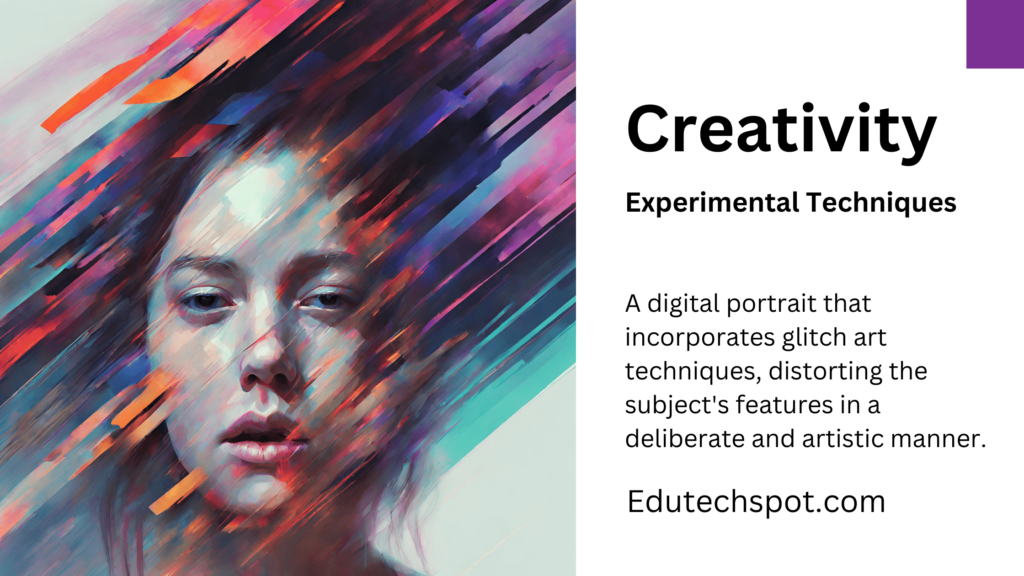
Creativity: The essence of digital art is rooted in boundless creativity, making it a fertile ground for artistic expression. Here, you have the freedom to explore innovative ideas that challenge the boundaries of your imagination and foster a deeper connection with your art.
Characteristics: Creativity in digital art is characterized by its unrestricted nature. Artists are encouraged to think beyond conventions, experiment with novel concepts, and push the limits of their skills and tools to produce truly unique and imaginative pieces.
Examples:
- Abstract Expressionism: Dive into the world of abstract digital art, where you can let your emotions and instincts guide your brush strokes. Create artworks that convey feelings, moods, or ideas without the constraints of realistic representation.Example: A digital painting filled with vibrant, swirling colors that evoke a sense of energy and emotion.
- Mashup and Remix: Combine disparate elements from various sources to create unexpected and thought-provoking compositions. Merge different art styles, genres, or themes to craft a new narrative.Example: A digital collage that fuses classical art with contemporary pop culture icons, creating a surreal and intriguing juxtaposition.
- Experimental Techniques: Embrace unconventional techniques and tools within your digital art software. Explore the use of filters, distortions, and layer effects to transform your artwork into something entirely unexpected.Example: A digital portrait that incorporates glitch art techniques, distorting the subject’s features in a deliberate and artistic manner.
- Surrealism: Delve into the dreamlike world of surrealism, where reality and fantasy coexist in a visually stunning and thought-provoking manner. Create scenes that challenge the viewer’s perceptions and invite them into a new realm of imagination.Example: A digital artwork featuring a floating elephant in a cityscape filled with floating clocks, reminiscent of Salvador Dalí’s iconic “The Persistence of Memory.”
- Fantasy World-Building: Construct your own fantastical worlds with unique creatures, landscapes, and cultures. Let your creativity flourish as you design entire universes from scratch.Example: A digital illustration of an otherworldly forest inhabited by glowing, bioluminescent creatures, where trees have iridescent leaves.
- Digital Mixed Media: Combine traditional and digital art techniques, incorporating elements like scanned sketches or paintings into your digital artwork. This blending of mediums can result in intriguing textures and depth.Example: A digital portrait overlaid with scanned watercolor textures, adding an organic and tactile quality to the image.
- Emotive Art: Create art that conveys powerful emotions, whether it’s joy, sadness, anger, or serenity. Use color, composition, and symbolism to evoke specific feelings in your audience.Example: A digital artwork depicting a lone figure standing in the rain, conveying a sense of melancholy and introspection.
By embracing and nurturing your creativity in the realm of digital art, you have the opportunity to produce works that are not only visually captivating but also deeply meaningful. Explore these creative avenues, experiment fearlessly, and let your imagination soar as you embark on your digital art journey.
Redraw Challenge
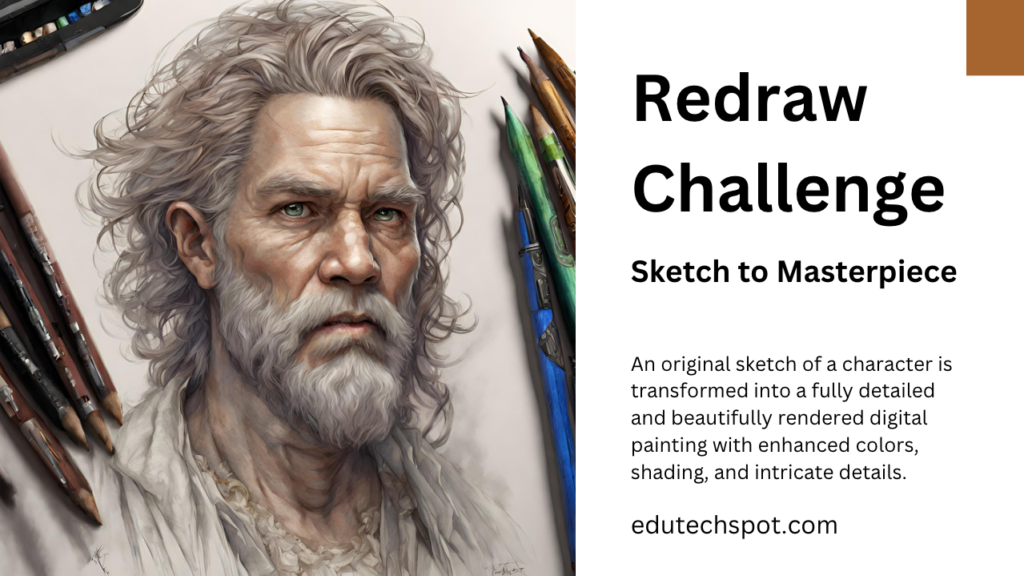
Redraw Challenge: Engaging in the redraw challenge is an excellent exercise that allows artists to breathe new life into their previous artwork. This popular challenge involves revisiting and reimagining older creations, offering an opportunity for growth, reflection, and artistic improvement.
Characteristics: The redraw challenge is characterized by its reflective nature. It encourages artists to assess their artistic development, identify areas for improvement, and showcase their progress by enhancing older pieces. This challenge fosters a sense of nostalgia and offers a visual representation of an artist’s journey.
Examples:
- Sketch to Masterpiece: Begin with a simple sketch or early digital artwork from your past. Reinterpret it with your current skills and vision, transforming it into a refined masterpiece.Example: An original sketch of a character is transformed into a fully detailed and beautifully rendered digital painting with enhanced colors, shading, and intricate details.
- Style Evolution: Choose artwork that represents a specific period in your artistic journey. Redraw it using your current artistic style, demonstrating how your approach has evolved over time.Example: An early cartoon-style illustration is revisited with a more realistic and detailed approach, showcasing the artist’s growth in technique.
- Concept Refinement: Revisit a concept or idea you explored in the past. Apply your newfound knowledge and skills to refine the concept, making it more compelling and visually striking.Example: A concept for a futuristic cityscape is revisited, incorporating advanced lighting and architectural design for a more immersive and detailed result.
- Color and Composition Enhancement: Take an older artwork and improve its color palette and composition. Use your current understanding of color theory and composition to elevate the piece.Example: A previously cluttered composition is simplified, and the color palette is harmonized to create a more visually pleasing and balanced artwork.
- Storytelling Evolution: Revisit an older narrative-focused artwork and enhance its storytelling elements. Add depth to the characters, refine the narrative, and create a more engaging visual story.Example: A scene from a fantasy story is revisited, with characters displaying more complex emotions, and the environment telling a richer narrative.
- Technical Skill Showcase: Choose an older artwork where you struggled with specific technical aspects. Redraw it to demonstrate your improved proficiency in those areas.Example: An earlier piece with challenging anatomy is redrawn with anatomical accuracy and better understanding of proportions.
- Personal Growth Celebration: Celebrate personal growth and milestones by redrawing an artwork from a significant point in your artistic journey. Highlight the progress you’ve made since then.Example: A redrawn self-portrait showcases not only improved technical skills but also a more confident and self-assured artist.
The redraw challenge is not just an opportunity for self-assessment and improvement; it’s a testament to the artist’s dedication to their craft. It showcases the transformative power of practice and the rewarding journey of artistic development. Participating in this challenge can be a gratifying and inspiring experience for digital artists at any level of expertise.
Inspiration from Animals
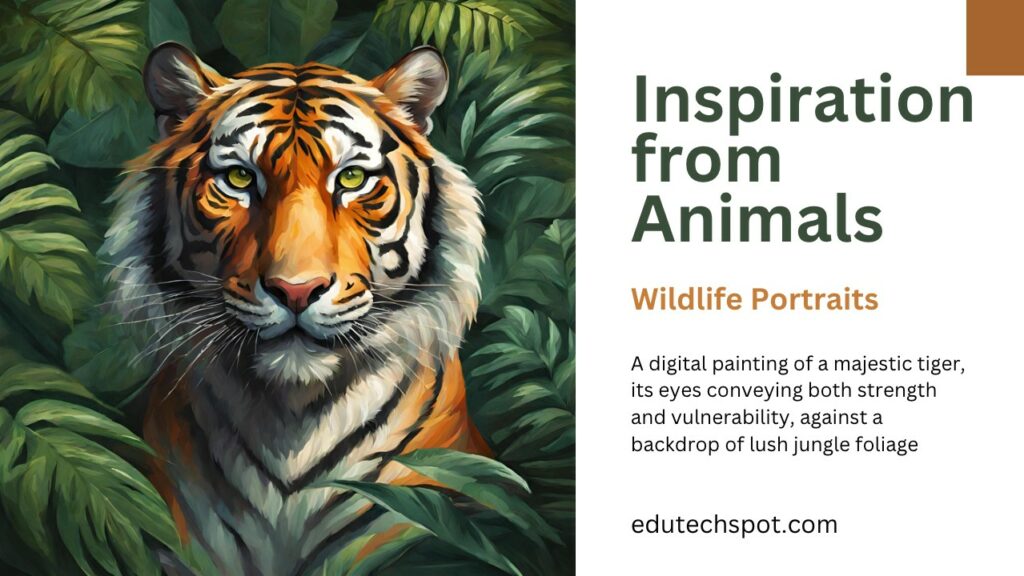
Inspiration from Animals: Finding inspiration from the rich tapestry of the animal kingdom can infuse your digital art with an unparalleled sense of vitality and beauty. Drawing upon the incredible diversity of creatures that inhabit our world can lead to the creation of captivating and emotionally resonant digital masterpieces.
Characteristics: Drawing inspiration from animals often involves a deep appreciation for the aesthetics, behaviors, and symbolism associated with different species. It encourages artists to observe nature’s wonders, empathize with animal subjects, and translate their essence into visually compelling art.
Examples:
- Wildlife Portraits: Create detailed and lifelike digital portraits of animals, focusing on capturing their unique features, expressions, and personalities.Example: A digital painting of a majestic tiger, its eyes conveying both strength and vulnerability, against a backdrop of lush jungle foliage.
- Animal Symbolism: Explore the symbolic meanings and cultural significance of animals in various societies. Incorporate these symbols into your digital artwork to convey deeper messages.Example: A digital illustration of an owl, symbolizing wisdom and mystery, rendered in a dreamy, enigmatic forest setting.
- Animal Anatomy Studies: Dive into the intricacies of animal anatomy by conducting detailed studies. Develop a better understanding of bone structure, muscle composition, and fur textures to enhance the realism of your digital art.Example: A digital artwork showcasing a beautifully rendered cheetah in full sprint, capturing the grace and power of its movements.
- Fantasy Creatures: Draw inspiration from real animals to design imaginative fantasy creatures. Blend elements of different species to create captivating and otherworldly beings.Example: A digital creation that combines the elegance of a seahorse with the majesty of a dragon, resulting in a unique aquatic fantasy creature.
- Ecosystem Art: Craft digital art pieces that depict entire ecosystems, highlighting the interconnectedness of flora and fauna.Example: A digital landscape showcasing a thriving coral reef teeming with vibrant marine life, including fish, sea turtles, and coral formations.
- Endangered Species Awareness: Use your art as a medium for raising awareness about endangered or threatened species. Highlight the importance of conservation efforts through your digital masterpieces.Example: A digital collage featuring a montage of endangered animals, each surrounded by symbols of conservation and hope.
- Animal Allegories: Create allegorical digital art that uses animals to convey human emotions, stories, or moral lessons.Example: A digital composition featuring a wise old tortoise imparting wisdom to a young rabbit, illustrating the value of patience.
- Animal Abstracts: Experiment with abstract interpretations of animals, focusing on capturing the essence and energy of the creatures rather than their physical forms.Example: An abstract digital artwork that evokes the spirit of a galloping horse through dynamic lines and colors.
Drawing inspiration from the animal kingdom not only celebrates the wonder of the natural world but also allows artists to connect with viewers on a primal and emotional level. Whether your digital art aims to depict the beauty of wildlife, convey environmental messages, or explore the mystical aspects of animals, the animal kingdom offers an endless source of inspiration for your digital masterpieces.
Digital Collage
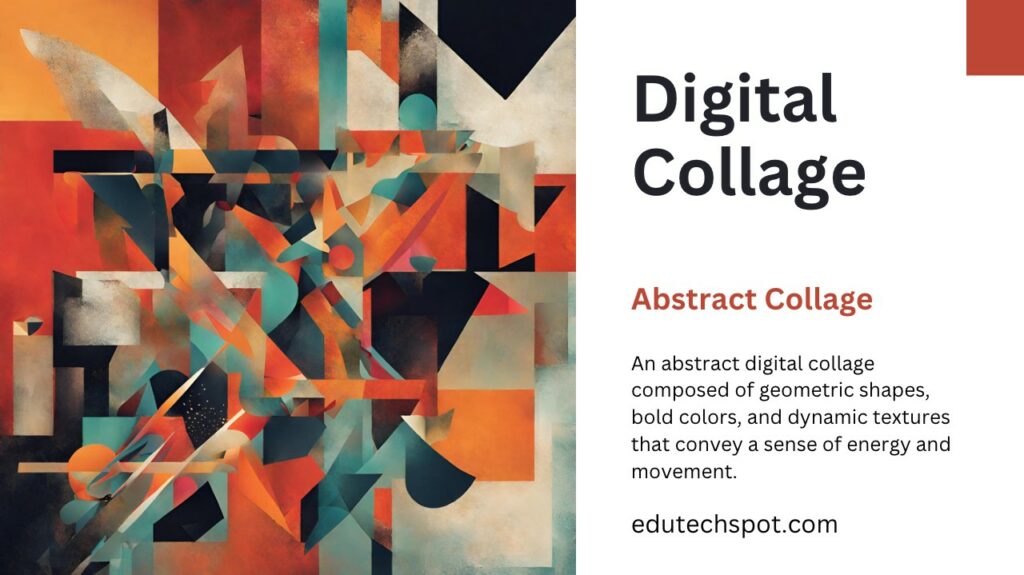
Digital Collage: Embarking on a journey into the realm of digital collage opens up a world of artistic possibilities where disparate elements come together to form a harmonious and captivating composition. This creative approach allows artists to seamlessly blend various visual elements, textures, and ideas into a cohesive and visually engaging whole.
Characteristics: Digital collage is characterized by its versatility and ability to transcend traditional boundaries. It encourages artists to experiment with combining photographs, illustrations, textures, and other digital elements to create layered and multidimensional compositions.
Examples:
- Nature and Urban Fusion: Merge elements of the natural world, such as trees, leaves, and animals, with urban scenes, architecture, and cityscapes to create a captivating juxtaposition.Example: A digital collage that seamlessly combines a bustling city skyline with lush, overgrown vegetation, symbolizing the contrast between urban life and nature.
- Vintage-Inspired Collage: Craft digital collages with a vintage aesthetic by incorporating old photographs, retro illustrations, and faded textures to evoke nostalgia and charm.Example: A digital collage featuring sepia-toned photographs, vintage advertisements, and handwritten letters, reminiscent of a bygone era.
- Abstract Collage: Experiment with abstract digital collage, using shapes, colors, and textures to create non-representational compositions that evoke emotion and intrigue.Example: An abstract digital collage composed of geometric shapes, bold colors, and dynamic textures that convey a sense of energy and movement.
- Storytelling Collage: Tell a visual story by combining elements that narrate a specific theme or concept. This form of digital collage can serve as a powerful storytelling tool.Example: A narrative digital collage that unfolds the journey of a character, featuring key moments and symbols that represent their transformation.
- Surreal Collage: Dive into surrealism by merging unrelated and dreamlike elements, resulting in compositions that challenge reality and invite viewers into a world of imagination.Example: A surreal digital collage featuring a floating piano surrounded by flying fish and raindrops, evoking a sense of whimsical wonder.
- Mixed Media Collage: Combine various digital and traditional art mediums in your collage. Incorporate elements like watercolor textures, ink sketches, and digital painting to add depth and texture.Example: A mixed media digital collage that blends a hand-painted watercolor background with digital illustrations and photographs.
- Typography and Collage: Experiment with text and typography in your collages. Use letters, words, and phrases to add meaning, context, or aesthetic value to your composition.Example: A digital collage that incorporates vintage newspaper clippings, handwritten notes, and typographic elements to create a layered narrative.
- Cultural Collage: Explore cultural diversity by incorporating elements from different cultures, such as symbols, patterns, and traditional art forms, into your digital collage.Example: A digital collage that fuses elements of Japanese ukiyo-e art with African tribal motifs, celebrating the beauty of cultural exchange.
Digital collage offers a dynamic and innovative approach to visual storytelling and artistic expression. It challenges artists to think beyond the confines of single mediums and invites them to explore the exciting intersection of various elements. Whether you aim to convey a powerful message, evoke emotions, or simply experiment with aesthetics, digital collage is a versatile and rewarding avenue for creative exploration.
Freehand Drawing
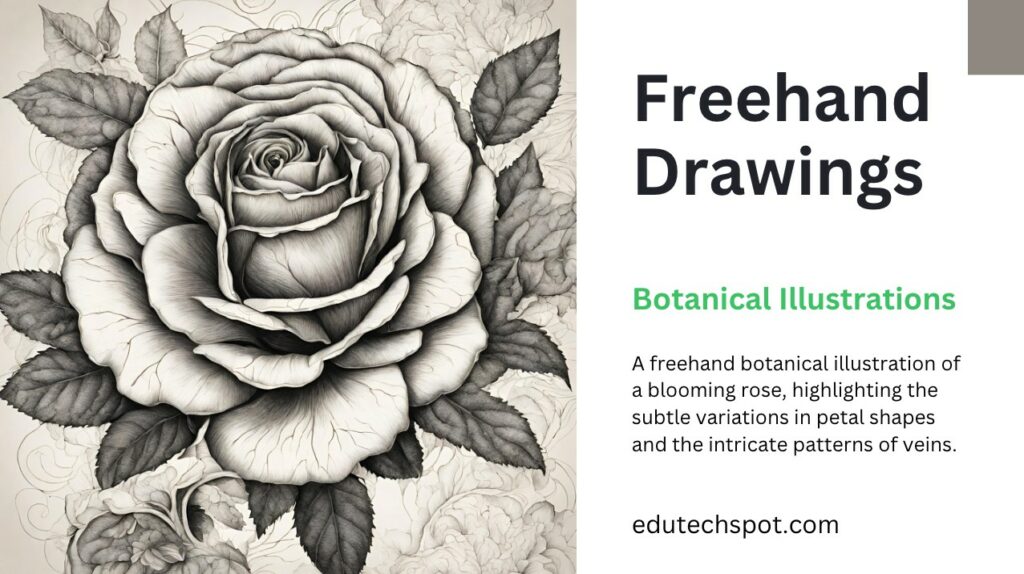
Freehand Drawing: The art of freehand drawing is a testament to an artist’s skill, precision, and ability to create intricate and captivating art without the aid of external tools or digital aids. It celebrates the raw connection between the artist’s hand and the canvas, resulting in truly unique and expressive creations.
Characteristics: Freehand drawing is characterized by its directness and immediacy. It requires artists to trust their instincts, allowing their hand to flow freely and create art without the constraints of rulers, templates, or digital assistance. It often reveals the artist’s personality and emotional connection to the artwork.
Examples:
- Portrait Sketches: Showcase your mastery of freehand drawing by creating lifelike portrait sketches. Capture the nuances of facial expressions, emotions, and personality with just a pencil or pen.Example: A freehand portrait sketch that beautifully captures the intricate details of a subject’s face, conveying their unique character and mood.
- Botanical Illustrations: Explore the natural world through freehand botanical illustrations. Draw intricate flowers, leaves, and plants, paying attention to the delicate details and textures.Example: A freehand botanical illustration of a blooming rose, highlighting the subtle variations in petal shapes and the intricate patterns of veins.
- Architectural Sketches: Demonstrate your ability to create intricate architectural sketches by capturing the beauty of buildings, landmarks, and urban scenes with freehand precision.Example: A freehand architectural sketch of a historic cathedral, showcasing intricate details in the Gothic architecture.
- Wildlife Drawings: Express your love for wildlife through freehand animal drawings. Capture the grace, strength, and beauty of creatures from the animal kingdom.Example: A freehand drawing of a majestic eagle in mid-flight, showcasing the intricacies of its feathers and determined expression.
- Fantasy Art: Create intricate fantasy art by drawing mythical creatures, fantastical landscapes, and magical realms freehand. Let your imagination run wild.Example: A freehand drawing of a mythical dragon perched atop a towering, intricately detailed castle in a fantastical landscape.
- Character Sketches: Develop your character design skills through freehand character sketches. Craft unique and expressive characters with distinct personalities.Example: A freehand character sketch of a whimsical, mischievous gnome, showcasing intricate clothing details and a mischievous grin.
- Still Life: Experiment with still life compositions, drawing intricate arrangements of everyday objects, and paying attention to light, shadow, and texture.Example: A freehand still life drawing featuring a carefully arranged assortment of antique objects, highlighting intricate details and reflective surfaces.
- Abstract Expressions: Embrace abstract freehand drawing as a means of expressing emotions and ideas through spontaneous lines, shapes, and forms.Example: An abstract freehand drawing that conveys a sense of chaos and energy through dynamic and intricate compositions of lines and patterns.
Freehand drawing is a celebration of an artist’s unique vision and their intimate connection with the medium. It allows for artistic spontaneity, unfettered expression, and the opportunity to convey intricate details and emotions through the simplest of tools—just pen or pencil and paper. Whether you’re sketching the human form, exploring the natural world, or delving into the realms of fantasy, freehand drawing is a powerful and personal means of artistic expression.
Portrait
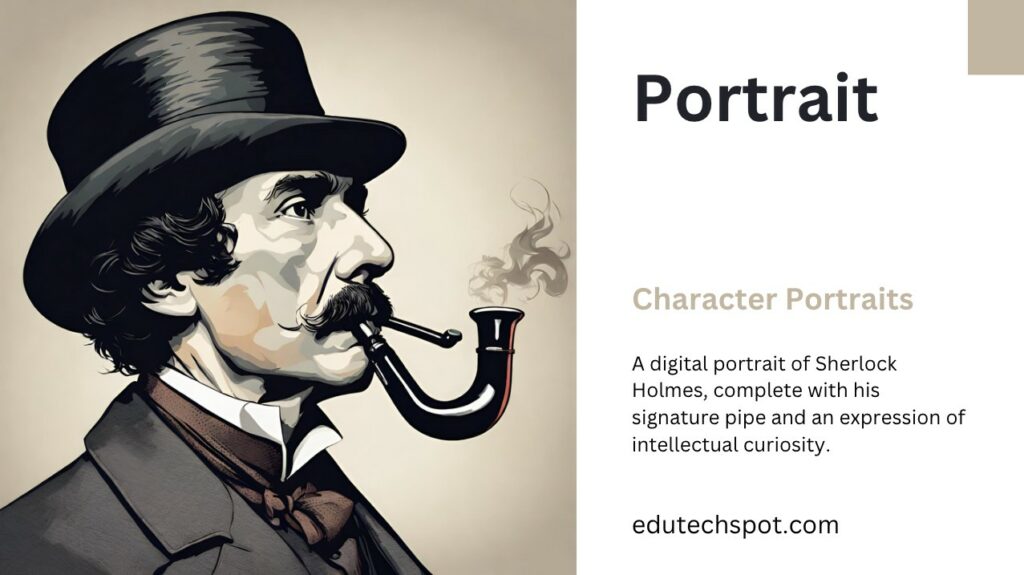
Portrait: The art of portraiture in the digital realm offers a profound avenue for artists to capture the essence, personality, and unique characteristics of individuals. Digital portraits serve as powerful tools for storytelling, conveying emotions, and celebrating the beauty of human diversity.
Characteristics: Digital portraits are characterized by their attention to detail and their ability to convey the subject’s identity, emotions, and personal narrative. These artworks often showcase the artist’s skill in rendering facial features, expressions, and nuances with precision and sensitivity.
Examples:
- Realistic Digital Portraits: Create lifelike digital portraits that intricately depict the subject’s features, skin texture, and facial expressions, allowing viewers to connect with the individual on a personal level.Example: A digital portrait that flawlessly captures the subject’s eyes, wrinkles, and subtle expressions, revealing their wisdom and life experiences.
- Character Portraits: Craft digital portraits of fictional or historical characters, capturing their distinct personalities, emotions, and iconic traits.Example: A digital portrait of Sherlock Holmes, complete with his signature pipe and an expression of intellectual curiosity.
- Caricatures: Explore the realm of caricature by exaggerating certain features or traits of the subject to convey humor, satire, or playful exaggeration.Example: A caricatured digital portrait of a politician with exaggerated facial features and humorous elements.
- Emotional Portraits: Convey powerful emotions and narratives through digital portraits that capture the subject’s mood, inner turmoil, or moments of introspection.Example: A digital portrait of a young woman gazing into the distance with a pensive expression, evoking a sense of contemplation.
- Fantasy Portraits: Blend realism with elements of fantasy to create captivating digital portraits of characters from fictional worlds, showcasing their unique qualities and magical elements.Example: A digital portrait of an elven warrior adorned with ethereal armor and surrounded by enchanted flora.
- Cultural Portraits: Celebrate diversity by creating digital portraits that depict individuals from various cultures, highlighting their traditional clothing, accessories, and cultural symbols.Example: A digital portrait of an indigenous tribal elder, adorned with intricate tribal markings and traditional attire.
- Digital Self-Portraits: Challenge yourself by creating a digital self-portrait that reflects your own identity, emotions, or personal journey.Example: A digital self-portrait that explores the artist’s emotions through expressive brushwork and color choices.
- Group Portraits: Expand your storytelling abilities by composing digital portraits of groups or families, capturing the dynamics, relationships, and connections between individuals.Example: A digital group portrait of a multi-generational family, showcasing the bonds and interactions among family members.
Digital portraits offer a window into the human experience, allowing artists to explore the depths of personality, emotion, and identity. Whether they depict real individuals or characters from the realms of fiction and fantasy, these artworks have the power to convey stories, evoke empathy, and celebrate the richness of the human spirit. Digital portrait artists wield their skills to capture the essence of individuals, preserving their unique narratives and contributions to the world.
Landscape Drawing
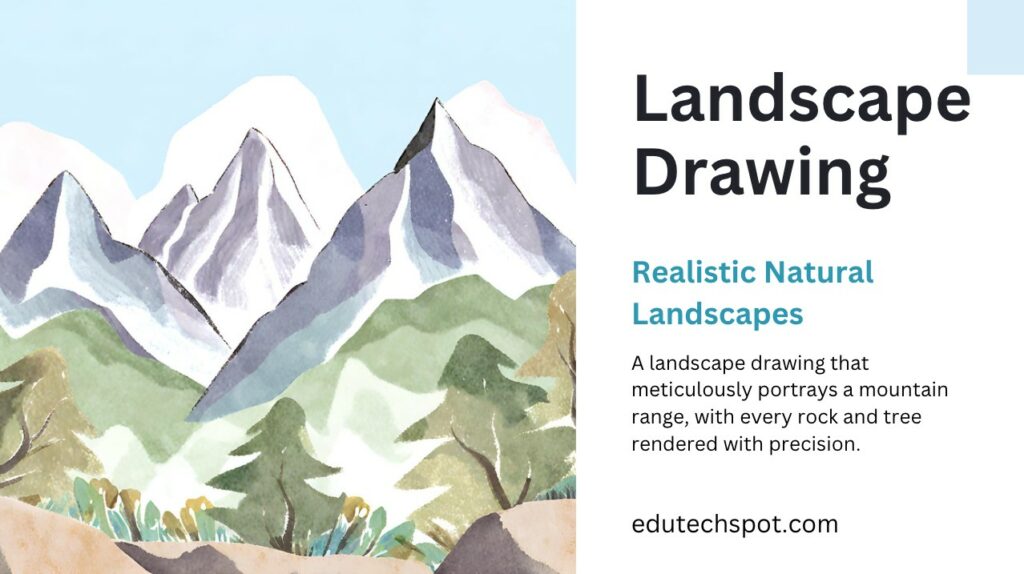
Landscape Drawing: The art of landscape drawing invites artists to capture the beauty and essence of natural and urban settings through meticulous and expressive representations. Whether it’s a serene countryside or a bustling cityscape, landscape art allows for the exploration of the world’s diverse and captivating environments.
Characteristics: Landscape drawing is characterized by its attention to detail, composition, and the depiction of the environment’s unique features. It often involves the use of various techniques to convey the mood, atmosphere, and visual splendor of a particular location.
Examples:
- Realistic Natural Landscapes: Create highly detailed and realistic landscape drawings of natural settings, such as mountains, forests, and seascapes. These drawings showcase the artist’s ability to capture the intricacies of nature.Example: A landscape drawing that meticulously portrays a mountain range, with every rock and tree rendered with precision.
- Urban Cityscapes: Capture the energy and complexity of urban environments by drawing cityscapes with towering skyscrapers, bustling streets, and intricate architectural details.Example: A detailed urban landscape drawing featuring a bustling city square with pedestrians, traffic, and vibrant street life.
- Impressionistic Landscapes: Embrace impressionism to convey the mood and atmosphere of a landscape with bold brushwork, vivid colors, and a focus on capturing the essence of a scene.Example: An impressionistic landscape drawing of a tranquil lakeside scene, with dappled sunlight and loose, expressive brushstrokes.
- Minimalist Landscapes: Explore minimalism by simplifying the landscape to its essential elements. Use negative space and minimal detail to convey a sense of calm and simplicity.Example: A minimalist landscape drawing that portrays a solitary tree against a vast, empty sky, emphasizing solitude and contemplation.
- Seasonal Changes: Create landscape drawings that depict the same location across different seasons, showcasing the transformation of natural settings throughout the year.Example: A series of landscape drawings that portray a forest clearing in spring, summer, autumn, and winter, highlighting the changing colors and moods.
- Architectural Landmarks: Draw iconic architectural landmarks and historical buildings within landscapes to emphasize their significance and cultural context.Example: A landscape drawing featuring the Eiffel Tower in the heart of Paris, surrounded by the charming streets of the city.
- Abstract Landscapes: Experiment with abstract landscapes that focus on form, color, and emotion rather than realistic representation, inviting viewers to interpret and connect with the art on a personal level.Example: An abstract landscape drawing that uses bold, geometric shapes and vibrant colors to convey a sense of energy and dynamism.
- Digital Mixed Media Landscapes: Combine traditional and digital techniques to create unique landscape drawings. Incorporate scanned textures or traditional sketches into your digital art to add depth and texture.Example: A digital landscape drawing that blends a digitally painted forest with scanned watercolor textures to create a rich and textured composition.
Landscape drawing offers a canvas for artists to explore the world’s diverse landscapes and to convey the beauty, atmosphere, and emotion inherent in these settings. Whether it’s the natural world’s serene tranquility or the urban landscape’s dynamic energy, landscape art captures the essence of places and allows viewers to experience the wonder and diversity of our planet.
Fan Art
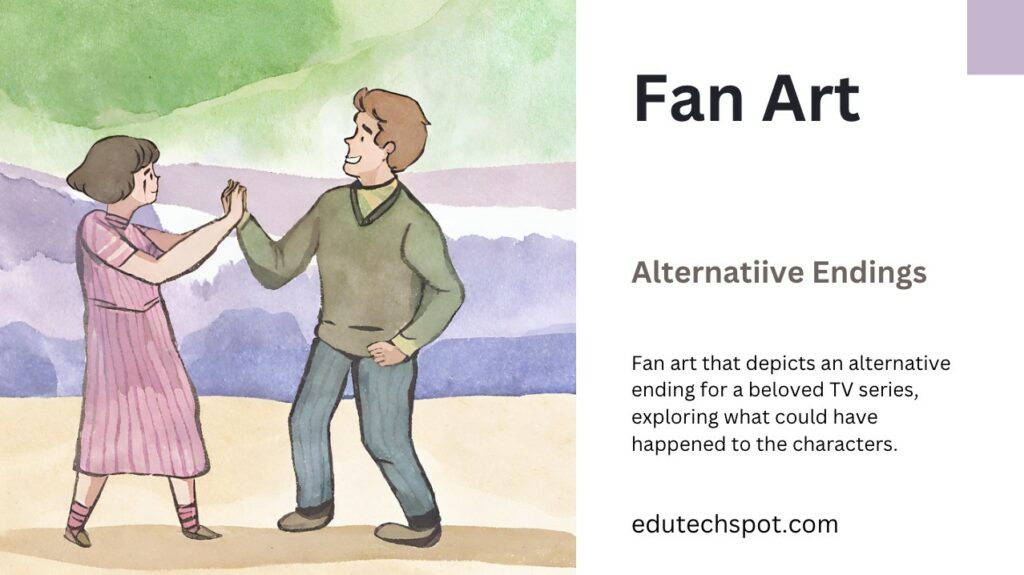
Fan Art: The world of fan art is a vibrant and passionate community where artists pay homage to their favorite pop culture icons, franchises, and characters. Through fan art, artists celebrate and reinterpret these beloved creations, capturing the hearts of fellow enthusiasts and creating a powerful connection through shared fandom.
Characteristics: Fan art is characterized by its deep appreciation for the source material, whether it’s a movie, TV series, video game, book, or comic. Artists channel their creativity to reimagine, reinterpret, or expand upon existing characters and worlds, infusing their own style and perspective into the artwork.
Examples:
- Character Portraits: Create detailed and emotive character portraits that highlight the personality and essence of beloved characters from movies, TV shows, or video games.Example: A fan art portrait that captures the iconic features and expression of a beloved superhero, enhancing their heroic qualities.
- Crossover Fan Art: Blend different pop culture universes by combining characters and elements from different franchises, creating unexpected and thrilling mashups.Example: Crossover fan art that brings together characters from a fantasy book series and a popular video game, exploring how they might interact in a shared world.
- Reimagined Costumes: Design alternative costumes or outfits for well-known characters, offering fresh perspectives and sparking conversations about character design.Example: Fan art that reimagines a classic superhero’s costume with a modern and edgier look, emphasizing their evolution.
- Alternative Endings: Create fan art that envisions alternative storylines or endings for TV shows, movies, or books, offering fans a glimpse into different narrative possibilities.Example: Fan art that depicts an alternative ending for a beloved TV series, exploring what could have happened to the characters.
- Character Redesigns: Redesign and modernize classic characters, giving them a contemporary or futuristic makeover while preserving their core identity.Example: Fan art that reimagines a retro video game character with sleek, cyberpunk-inspired aesthetics.
- Iconic Moments: Recreate iconic scenes or moments from pop culture, capturing the emotions and significance of these pivotal events.Example: Fan art that faithfully reproduces a famous movie scene, evoking nostalgia and emotional resonance.
- Fan-Made Comics: Craft fan-made comics that expand upon the lore, backstory, or untold adventures of favorite characters, offering a deeper dive into their world.Example: A fan-made comic that explores the childhood adventures of a well-known hero, revealing their formative experiences.
- Tribute Art: Pay tribute to creators, actors, or artists who have left a significant impact on pop culture through their work.Example: Fan art that honors the legacy of a beloved author or actor, featuring them alongside their iconic characters.
Fan art is a testament to the enduring and transformative power of storytelling and creativity within pop culture. It fosters a sense of community among enthusiasts who share a deep love for these iconic worlds and characters. Through fan art, artists contribute their unique perspectives and talents to the ongoing narrative of beloved franchises, enriching the collective experience of fans worldwide.
2D Painting
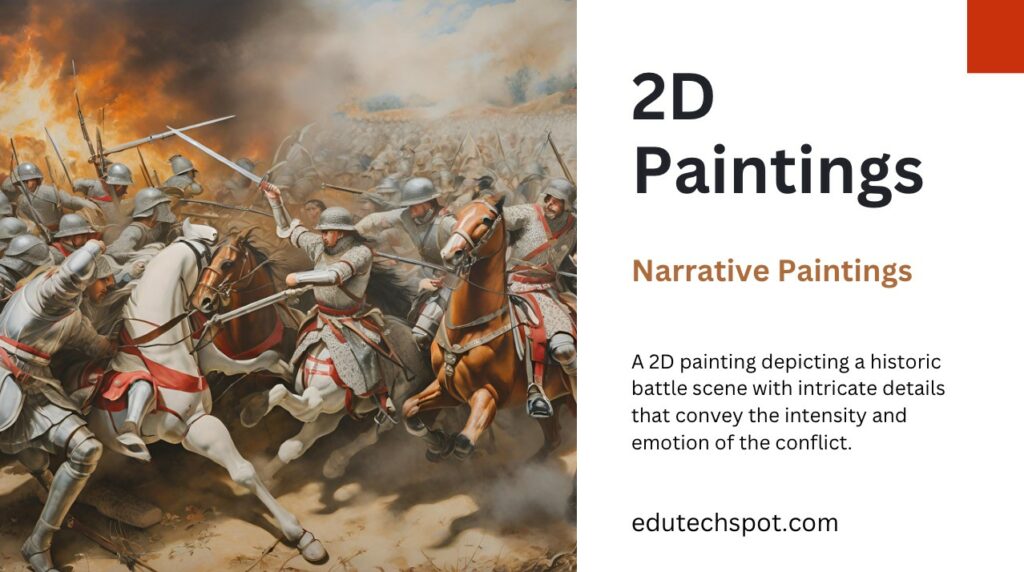
2D Painting: The art of 2D painting is a timeless and expressive medium that allows artists to craft visually engaging masterpieces capable of telling stories, evoking emotions, and conveying complex narratives. Whether it’s on canvas, paper, or a digital screen, 2D paintings are powerful vessels for artistic expression.
Characteristics: 2D painting is characterized by its use of color, composition, and texture to create images that capture the imagination and stir the soul. It often involves the artist’s mastery of techniques like brushwork, layering, and blending to achieve desired effects.
Examples:
- Narrative Paintings: Create narrative-driven 2D paintings that unfold a story within a single frame. These paintings often feature multiple characters, settings, and events, allowing viewers to explore a story visually.Example: A 2D painting depicting a historic battle scene with intricate details that convey the intensity and emotion of the conflict.
- Emotive Portraits: Craft emotionally charged portrait paintings that reveal the inner thoughts, feelings, and personalities of the subjects. Portraits often serve as windows into the human experience.Example: A 2D portrait painting that captures the vulnerability and resilience of an elderly subject, their eyes reflecting a lifetime of experiences.
- Landscape Narratives: Use landscapes as a backdrop for storytelling. Create 2D paintings that transport viewers to distant worlds, allowing them to immerse themselves in the atmosphere and ambiance of the setting.Example: A 2D landscape painting that depicts a desolate, post-apocalyptic cityscape, conveying a sense of isolation and despair.
- Symbolic Art: Craft symbolic 2D paintings that use imagery and symbolism to convey abstract concepts, emotions, or philosophical ideas.Example: A 2D painting featuring a labyrinth of interconnected paths, symbolizing the complexity and challenges of life’s journey.
- Abstract Expressions: Explore abstract 2D paintings that rely on color, form, and texture to evoke emotions and invite viewers to interpret the art in their own unique way.Example: A vibrant and energetic 2D abstract painting that radiates a sense of joy and movement.
- Still Life Narratives: Create still life paintings that tell stories through carefully arranged objects, each with its own symbolism and significance.Example: A 2D still life painting featuring a table set with vintage items, hinting at a bygone era and the passage of time.
- Historical and Mythological Scenes: Paint historical events or mythological scenes, capturing the grandeur and drama of these epic moments in time.Example: A 2D painting depicting a legendary battle from mythology, complete with gods, heroes, and mythical creatures.
- Contemporary Commentary: Use 2D paintings as a medium for social and political commentary, addressing current issues, and inviting viewers to reflect on the world around them.Example: A 2D painting that explores environmental concerns through surreal and thought-provoking imagery.
2D painting is a rich and diverse medium that allows artists to communicate, provoke thought, and inspire through the visual language of color, form, and composition. Whether artists seek to tell a story, evoke emotions, or convey abstract concepts, the world of 2D painting offers boundless opportunities for creative expression and connection with viewers.
3D Painting
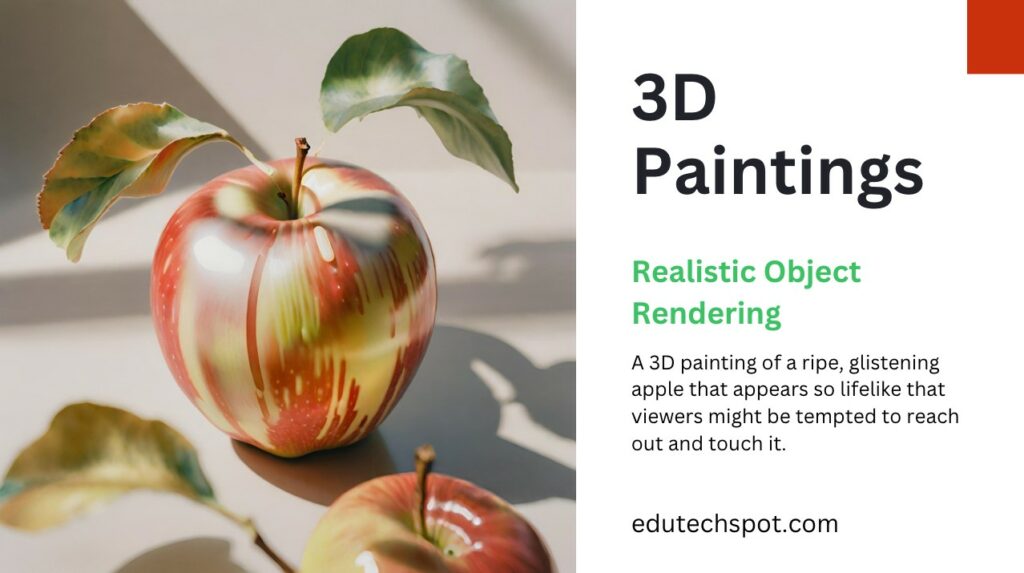
3D Painting: The realm of 3D painting opens up a new dimension of artistic expression, enabling artists to elevate their work by incorporating depth, volume, and a heightened sense of realism. Through various 3D painting techniques, artists can breathe life into their creations and engage viewers on a more immersive level.
Characteristics: 3D painting is characterized by its ability to create the illusion of three-dimensional space and objects on a two-dimensional surface. It often involves the use of shading, perspective, texture, and depth cues to achieve a heightened sense of realism.
Examples:
- Realistic Object Rendering: Create 3D paintings that render everyday objects with astonishing realism, paying meticulous attention to lighting, shadows, and texture.Example: A 3D painting of a ripe, glistening apple that appears so lifelike that viewers might be tempted to reach out and touch it.
- Architectural Visualization: Utilize 3D painting techniques to visualize architectural designs, interior spaces, and urban landscapes, allowing viewers to explore environments before they’re built.Example: A 3D painting depicting a modern, minimalist living room with accurate lighting, materials, and furnishings.
- Environmental Realism: Craft 3D paintings of natural landscapes that transport viewers to serene vistas and breathtaking wilderness, conveying the beauty and grandeur of nature.Example: A 3D painting capturing the tranquility of a misty mountain valley, where every rock, tree, and stream appears lifelike.
- Hyperrealistic Portraits: Elevate portrait painting to new heights with 3D techniques that bring out every pore, wrinkle, and glint in the eyes, immersing viewers in the subject’s presence.Example: A 3D portrait painting that depicts a person in such intricate detail that every strand of hair and subtle facial expression is visible.
- Fantasy Worlds: Create 3D paintings that transport viewers to imaginative and fantastical realms, where mythical creatures, enchanted landscapes, and magical elements come to life.Example: A 3D painting of an otherworldly forest inhabited by mythical beings, where the lush vegetation and mystical creatures appear three-dimensional.
- Sculptural Realism: Incorporate sculptural elements into 3D paintings, allowing viewers to appreciate the tactile qualities and three-dimensionality of objects within the artwork.Example: A 3D painting that features a sculpted, lifelike rose bursting out of the canvas, inviting viewers to experience its physical presence.
- Interactive Art: Combine traditional painting with augmented or virtual reality (AR/VR) technologies to create interactive 3D paintings that respond to viewer interactions.Example: A 3D painting in an art gallery that, when viewed through an AR app, transforms into an animated and interactive experience.
- Experimental Abstractions: Push the boundaries of 3D painting by exploring abstract and non-representational forms, playing with optical illusions, and challenging traditional concepts of space.Example: A 3D painting that uses optical illusions and layered textures to create the illusion of endless depth and movement.
3D painting techniques empower artists to transcend the limitations of the flat canvas and immerse viewers in a world of depth, texture, and realism. Whether artists aim to achieve hyperrealism, visualize architectural wonders, or transport viewers to fantastical realms, the realm of 3D painting offers a spectrum of creative possibilities that continue to redefine the boundaries of art and perception.
Doodle
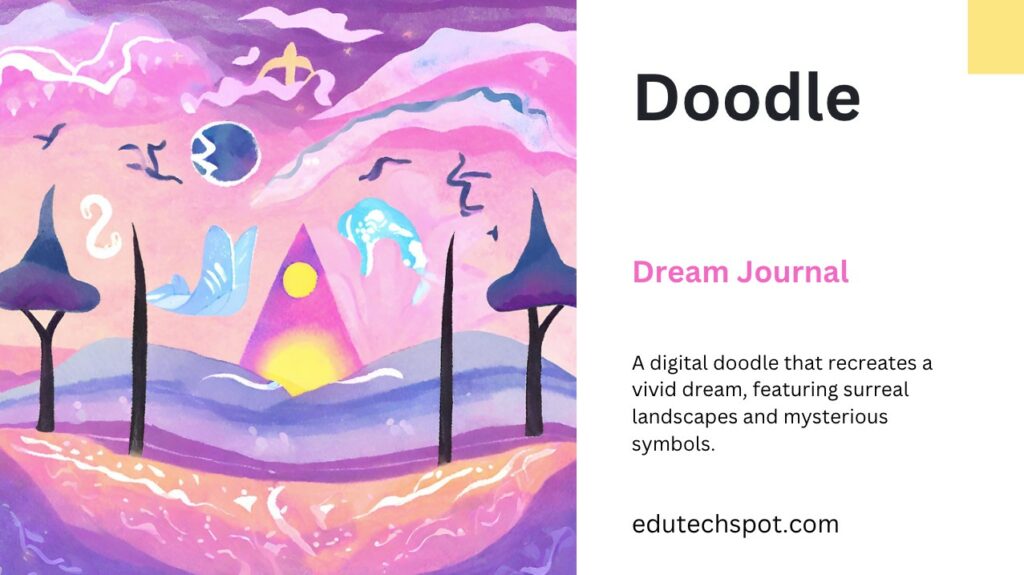
Doodle: Digital doodling is a form of spontaneous and free-flowing artistic expression that celebrates creativity in its raw and uninhibited state. It invites artists to let their imagination run wild, resulting in a delightful and often whimsical collection of drawings that capture moments of inspiration.
Characteristics: Doodling is characterized by its simplicity, playfulness, and lack of formal structure. It often involves using quick, spontaneous strokes to create drawings that may range from abstract patterns to recognizable objects, all driven by the artist’s momentary thoughts and emotions.
Examples:
- Abstract Doodles: Embrace abstraction by creating digital doodles that consist of intricate patterns, shapes, and lines. These doodles can be inspired by anything from the artist’s surroundings to their inner thoughts and emotions.Example: A digital doodle that features a swirling mix of lines and shapes, evoking a sense of dynamic movement and energy.
- Character Doodles: Bring quirky characters to life through digital doodling. These whimsical creations may have exaggerated features, humorous expressions, and unique personalities.Example: A digital doodle of a whimsical creature with oversized eyes, a mischievous grin, and playful accessories.
- Nature-inspired Doodles: Draw inspiration from the natural world by creating digital doodles of plants, animals, and landscapes. These doodles can capture the beauty and diversity of nature in a spontaneous and artistic manner.Example: A digital doodle featuring a whimsical forest scene with quirky animals and vibrant foliage.
- Word Doodles: Incorporate words and typography into your doodles to convey messages, ideas, or simply to add an extra layer of creativity to your artwork.Example: A digital doodle that combines hand-lettered phrases with illustrations, creating a visual and textual narrative.
- Doodle Collages: Merge multiple doodles into a single composition, creating eclectic and visually captivating collages that tell unique stories.Example: A digital doodle collage that combines abstract patterns, character sketches, and nature-inspired elements into a harmonious whole.
- Spontaneous Sketches: Let your imagination roam freely by creating spontaneous sketches of scenes, objects, or characters that come to mind in the moment.Example: A digital doodle that captures a fleeting vision of a fantastical flying machine, complete with whimsical details.
- Dream Journal Doodles: Use doodling as a form of visual journaling, capturing dreamlike and surreal imagery that reflects your subconscious thoughts and emotions.Example: A digital doodle that recreates a vivid dream, featuring surreal landscapes and mysterious symbols.
- Mood Doodles: Express your current mood or emotions through doodles, using colors, shapes, and gestures to convey feelings of joy, melancholy, excitement, or serenity.Example: A digital doodle that reflects a sense of serenity through soft, flowing lines and gentle, muted colors.
Digital doodling is a celebration of spontaneity and creativity, allowing artists to explore the limitless possibilities of their imagination. Whether it’s a simple doodle created during a moment of inspiration or an elaborate digital artwork composed of interconnected doodles, this art form encourages artists to embrace the joy of creating without constraints. It’s a reminder that art can be found in the most unscripted and unassuming moments of artistic expression.
Hybrid Artwork
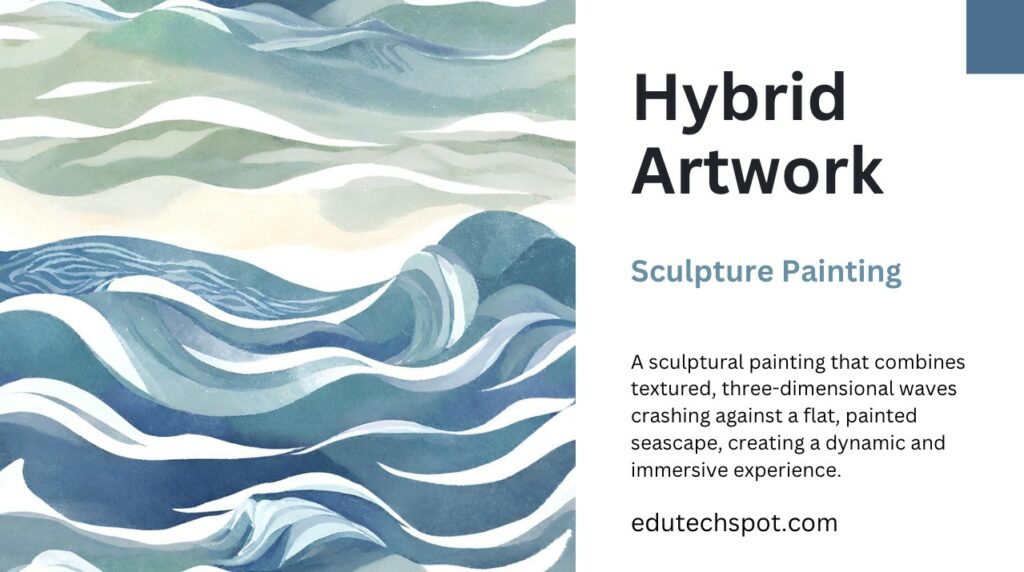
Hybrid Artwork: Hybrid artwork is a captivating fusion of different art forms, mediums, and styles, where creativity knows no bounds. It encourages artists to break free from traditional constraints and embrace the exciting possibilities that arise when diverse artistic elements converge into a single, harmonious composition.
Characteristics: Hybrid artwork is characterized by its eclecticism and versatility. It combines various artistic techniques, materials, and genres to create pieces that are uniquely expressive and thought-provoking.
Examples:
- Mixed Media Collages: Create hybrid artwork by layering different materials, such as paper, fabric, paint, and found objects, to produce collages that blend textures and colors in unexpected ways.Example: A mixed media collage that combines vintage photographs, acrylic paint, and torn pages from old books to create a nostalgic and visually rich composition.
- Digital Mixed Media: Combine digital and traditional art techniques by incorporating digital elements into physical artwork or vice versa. This approach allows artists to bridge the gap between the analog and digital worlds.Example: A traditional oil painting enhanced with digital elements, such as interactive QR codes or augmented reality overlays that reveal hidden layers of the artwork.
- Sculptural Paintings: Elevate your artistry by creating hybrid artwork that melds painting with sculpture. Incorporate three-dimensional elements, such as relief textures or sculpted forms, into your two-dimensional paintings.Example: A sculptural painting that combines textured, three-dimensional waves crashing against a flat, painted seascape, creating a dynamic and immersive experience.
- Photographic Mixed Media: Blend photography with various mediums, such as painting, collage, or digital manipulation, to create hybrid artwork that transforms photographs into captivating, multidimensional pieces.Example: A photographic mixed media artwork that combines a portrait photograph with painted layers and collage elements, offering a surreal and dreamlike quality.
- Cross-Genre Music and Visual Art: Collaborate with musicians or composers to create hybrid artwork that combines visual and auditory experiences. These works may feature synchronized projections, interactive installations, or live performances that intertwine music and art.Example: An immersive art installation where viewers can manipulate visual elements through touch or motion, creating a dynamic visual representation of a musical composition.
- Video Art Installations: Merge video, sculpture, and sound to craft immersive video art installations that transport viewers into otherworldly realms or challenge their perceptions of reality.Example: A video art installation that uses projection mapping to transform an entire room into a mesmerizing, immersive environment, combining moving images with sculptural elements.
- Interactive Digital Art: Create hybrid artwork by integrating interactive elements, such as sensors, touchscreens, or virtual reality, into your digital or physical pieces, inviting viewers to actively engage with and influence the art.Example: An interactive digital artwork that responds to the viewer’s gestures, allowing them to manipulate colors and shapes in real-time using touch or motion.
Hybrid artwork represents a dynamic and ever-evolving intersection of artistic practices, where creativity knows no boundaries. It encourages artists to push the limits of their craft, experiment with unconventional combinations, and redefine what art can be. Through the fusion of different mediums, styles, and perspectives, hybrid artwork offers a fresh and exciting way to engage with the world of art and to inspire new possibilities for creative expression.
Mathematical Artwork
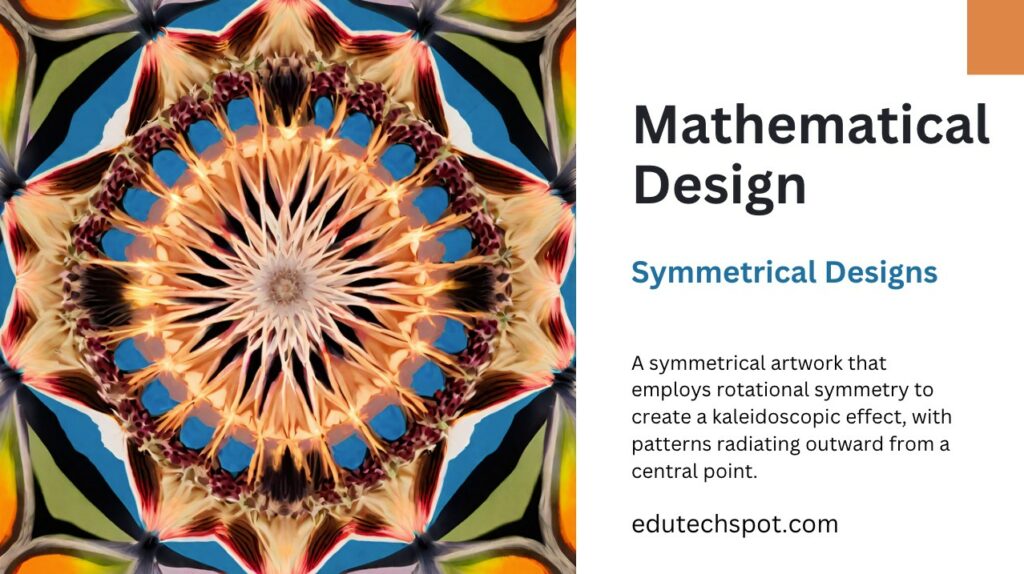
Mathematical Artwork: The fusion of mathematics and art gives rise to a mesmerizing genre known as mathematical artwork. It allows artists to explore the beauty of mathematical concepts, patterns, and structures through visual expression, resulting in intricate and intellectually engaging creations.
Characteristics: Mathematical artwork is characterized by its precise and calculated approach. Artists use mathematical formulas, algorithms, and geometric principles to create art that often showcases symmetry, fractals, tessellations, and other mathematical phenomena.
Examples:
- Fractal Art: Dive into the world of fractals, where complex mathematical equations give rise to self-replicating patterns. Fractal artwork often features intricate, infinitely repeating shapes and structures.Example: A fractal artwork that explores the Mandelbrot set, revealing a stunningly detailed and infinitely complex geometric landscape.
- Geometric Abstractions: Craft mathematical artwork that explores geometric shapes and structures. These pieces may involve precise calculations to create visually harmonious compositions.Example: A geometric artwork that uses precise mathematical ratios to create a visually pleasing arrangement of polygons and circles.
- Symmetrical Designs: Explore the concept of symmetry in your artwork, using mathematical principles to create perfectly balanced and mirrored compositions.Example: A symmetrical artwork that employs rotational symmetry to create a kaleidoscopic effect, with patterns radiating outward from a central point.
- Tessellation Art: Create tessellations by arranging geometric shapes in a way that covers a surface without overlapping. These mathematical patterns often result in captivating and repetitive designs.Example: A tessellation artwork featuring a school of fish, where each fish is composed of identical geometric tiles that seamlessly fit together.
- Optical Illusions: Utilize mathematical principles to design optical illusions that challenge viewers’ perceptions and create mind-bending visual experiences.Example: An optical illusion artwork that uses mathematical gradients and patterns to create the illusion of depth and movement on a flat surface.
- Mathematical Landscapes: Use mathematical algorithms to generate landscapes and terrain in your artwork, exploring the mathematical basis of natural forms.Example: A mathematical artwork that simulates the erosion patterns of canyons and valleys, showcasing the intricate detail of natural landscapes.
- Mathematical Color Theory: Experiment with mathematical color theory, using mathematical equations to determine color palettes and gradients in your artwork.Example: An artwork that employs mathematical color theory to create harmonious color schemes based on the principles of color harmony.
- Data Visualization Art: Transform complex data sets and scientific data into visually stunning art that conveys information through mathematical representations.Example: An artwork that visualizes climate data using mathematical algorithms to generate abstract, data-driven patterns and colors.
Mathematical artwork offers a captivating journey into the intersection of art and science. It invites viewers to appreciate the beauty of mathematical concepts and patterns, while also challenging artists to explore the mathematical foundations of creativity. This genre allows artists to engage both the analytical and imaginative sides of their minds, resulting in visually intriguing and intellectually stimulating masterpieces that inspire wonder and curiosity.
Geometric Shapes Art
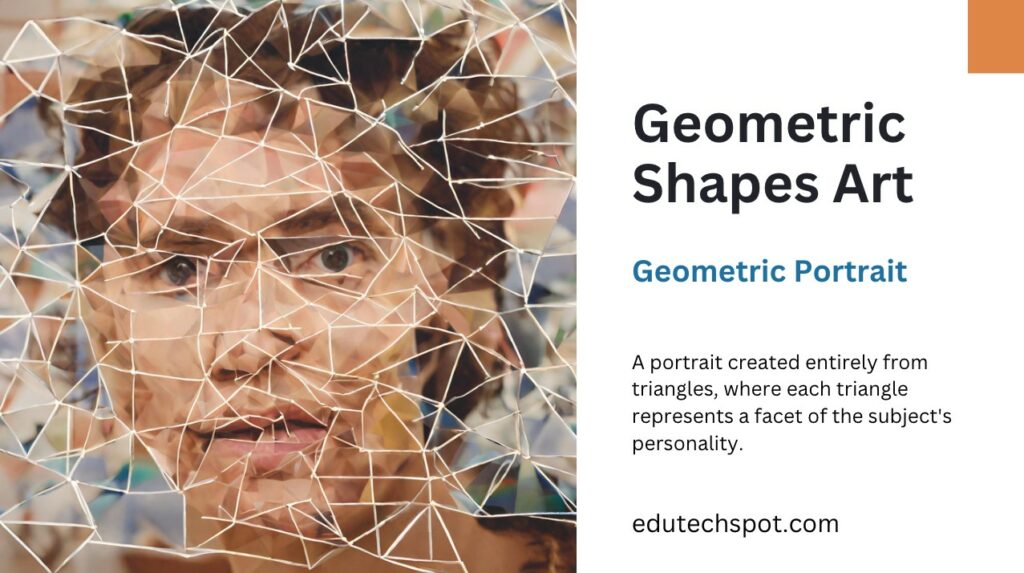
Geometric Shapes in Art: Exploring geometric shapes in art is a captivating journey into the world of precise forms, symmetry, and patterns. Artists who incorporate geometric shapes into their work have the opportunity to create mesmerizing compositions that celebrate the elegance and order inherent in these mathematical constructs.
Characteristics: Art featuring geometric shapes is characterized by its reliance on simple, well-defined forms such as circles, triangles, squares, and rectangles. These shapes are often used to create patterns, symmetry, and visual harmony within the artwork.
Examples:
- Geometric Abstractions: Craft abstract artworks that center around geometric shapes as the primary visual elements. These compositions may use shapes like squares, triangles, or circles to create intricate and visually appealing patterns.Example: An abstract artwork that features a repetitive pattern of interlocking hexagons, creating a visually engaging geometric design.
- Op Art: Explore Op Art (Optical Art) by using geometric shapes and patterns to create optical illusions, visual effects, and the perception of movement in two-dimensional art.Example: An Op Art piece that uses a grid of black and white squares to create the illusion of depth and motion when viewed from a distance.
- Minimalism: Embrace minimalism by using geometric shapes with precision and simplicity. Minimalist artworks often feature clean lines, solid colors, and a focus on spatial relationships.Example: A minimalist artwork that consists of a single red square on a white canvas, evoking a sense of purity and balance.
- Tessellations: Create tessellations, where geometric shapes fit together perfectly to cover a surface without gaps or overlaps. Tessellations can result in visually captivating and repeating patterns.Example: An artwork featuring a tessellating pattern of interlocking equilateral triangles, creating a seamless, geometric design.
- Geometric Portraits: Experiment with the use of geometric shapes to construct portraits or representations of subjects. This approach adds a unique and abstract dimension to portraiture.Example: A portrait created entirely from triangles, where each triangle represents a facet of the subject’s personality.
- Geometric Landscapes: Use geometric shapes to depict landscapes, architecture, or cityscapes, transforming natural and urban environments into geometric abstractions.Example: A cityscape artwork that simplifies buildings and streets into bold, geometric forms, emphasizing the structural elements.
- Mosaic Art: Create mosaic-style artworks using geometric shapes as the building blocks. This approach allows for the creation of intricate and colorful compositions.Example: A mosaic artwork composed of tessellating pentagons, each filled with different colors and patterns to form an intricate design.
- Mathematical Symmetry: Explore the concept of symmetry by incorporating geometric shapes into symmetrical compositions, where elements mirror each other along a central axis.Example: An artwork featuring a symmetrical arrangement of triangular shapes that create a harmonious and balanced design.
Geometric shapes in art offer artists a rich and versatile visual language that can convey precision, order, and aesthetic appeal. Whether artists seek to create abstract patterns, optical illusions, or minimalist compositions, the world of geometric art provides endless possibilities for creative exploration. It celebrates the allure of simplicity and symmetry while encouraging artists to experiment with the harmony of shapes and patterns.
Symmetrical Art
Symmetrical Art: The art of symmetry harnesses the captivating power of balance, reflection, and repetition to create harmonious and visually satisfying masterpieces. Symmetrical art celebrates the aesthetic appeal of order and equilibrium, inviting viewers to explore the beauty found in mirrored compositions.
Characteristics: Symmetrical art is characterized by its use of symmetry, where elements are arranged in a balanced and mirror-like fashion along a central axis. It often relies on precise alignment, creating a sense of visual harmony and unity within the artwork.
Examples:
- Bilateral Symmetry: Create artworks that feature bilateral symmetry, where the left and right sides of the composition mirror each other perfectly. This classic form of symmetry often produces visually pleasing and balanced designs.Example: An artwork of a butterfly with wings that are perfectly mirrored on each side, emphasizing the creature’s natural beauty and harmony.
- Radial Symmetry: Explore radial symmetry, where elements radiate outward from a central point, creating a circular or star-like composition. Radial symmetry offers a sense of balance and completeness.Example: A floral artwork with petals radiating symmetrically from the center, evoking a sense of blooming and fullness.
- Kaleidoscopic Patterns: Craft kaleidoscopic patterns that use symmetry to create mesmerizing, intricate designs. These patterns often consist of repeated shapes and colors that form captivating visual motifs.Example: A kaleidoscopic artwork that features a symmetrical arrangement of intricate mandala-like patterns, drawing viewers into a hypnotic visual experience.
- Mirror Image Paintings: Create mirror image paintings that explore reflections and duality. These artworks often feature subjects that are doubled, flipped, or reflected to convey a sense of unity and balance.Example: A mirror image painting of a tranquil lake scene, where the serene landscape is perfectly reflected in the still water.
- Geometric Symmetry: Use geometric shapes and patterns to construct symmetrical compositions. Geometric symmetry offers a structured and mathematical approach to creating visually satisfying art.Example: An artwork that uses geometric shapes, such as squares and triangles, to form an intricately symmetrical design.
- Symmetrical Portraits: Apply symmetrical principles to portraiture by capturing the likeness of a subject with perfectly balanced features, highlighting their inherent beauty and proportion.Example: A symmetrical portrait painting that emphasizes the subject’s facial symmetry and creates a sense of idealized beauty.
- Natural Symmetry: Celebrate the symmetry found in nature, from the symmetrical patterns of leaves to the radial symmetry of flowers. These artworks showcase the organic beauty of balance in the natural world.Example: An artwork that depicts the symmetrical patterns of a seashell, highlighting the precision and elegance of nature’s design.
- Abstract Symmetry: Explore abstract symmetrical compositions that rely on shape, color, and pattern to create balanced and visually captivating art.Example: An abstract artwork featuring a symmetrical arrangement of vibrant, interlocking shapes that evoke a sense of energy and unity.
Symmetrical art invites viewers to appreciate the harmonious balance and order that can be found in artistic creations. It offers a timeless and universal aesthetic that resonates with our innate sense of beauty and symmetry. Whether artists seek to capture the elegance of natural symmetry or experiment with geometric precision, symmetrical art serves as a visual testament to the captivating allure of balance and reflection.
Action Painting
Action Painting: Action painting is a dynamic and expressive form of art that emphasizes the act of creation itself. It celebrates spontaneity, movement, and the raw, authentic expression of emotions through bold and energetic brushwork or gestural techniques.
Characteristics: Action painting is characterized by its emphasis on the physical process of painting. Artists often use large canvases, drips, splatters, and gestural marks to convey their emotions, energy, and creativity directly onto the artwork.
Examples:
- Drip Painting: Embrace the iconic technique of drip painting, made famous by artists like Jackson Pollock. This method involves dripping or pouring paint onto a canvas to create intricate and often chaotic patterns.Example: An action painting created through drip techniques, where layers of vibrant colors crisscross the canvas in a mesmerizing dance of movement and spontaneity.
- Gestural Abstraction: Explore gestural abstraction by using bold and expressive brushwork to convey your emotions and intentions. This approach often results in abstract compositions filled with dynamic energy.Example: An action painting characterized by bold, sweeping brushstrokes that evoke a sense of movement and passion, inviting viewers to interpret the emotions within.
- Large-Scale Canvases: Create action paintings on large canvases that allow for unrestricted movement and uninhibited expression. The sheer scale of the artwork becomes an integral part of the artistic process.Example: An expansive action painting that spans an entire wall, immersing viewers in a world of color, texture, and movement.
- Emotional Release: Use action painting as a means of emotional release and catharsis. Express your innermost feelings and thoughts through the physical act of painting, allowing your emotions to flow freely.Example: An action painting that serves as a visual diary of an artist’s emotional journey, with layers of paint reflecting different moods and experiences.
- Color Exploration: Experiment with color in action painting to convey a wide range of emotions and moods. Vibrant hues, subtle shades, and bold contrasts become tools for visual storytelling.Example: An action painting that explores the spectrum of emotions through a dynamic interplay of colors, from serene blues to fiery reds.
- Body Movement: Incorporate bodily movements into the process of action painting. Let your entire body engage with the canvas, using gestures and physicality to create art.Example: An action painting where the artist used their entire body to apply paint, resulting in a piece that captures the essence of movement and human energy.
- Collaborative Action: Collaborate with others on action painting projects, where multiple artists contribute their emotions and expressions to a single artwork, reflecting a collective creative spirit.Example: An action painting created by a group of artists who took turns adding their unique contributions to a shared canvas, resulting in a multifaceted and collaborative masterpiece.
- Textured Surfaces: Experiment with texture in action painting by incorporating materials like sand, fabric, or mixed media to create tactile and multi-dimensional artworks.Example: An action painting that features a rich, textured surface with layers of paint, sand, and found objects, inviting viewers to explore both visually and tactilely.
Action painting serves as a powerful form of artistic self-expression, inviting artists to embrace spontaneity, movement, and the raw authenticity of their emotions. It offers a visceral and immediate connection between the artist and the canvas, producing artworks that are as much about the process as they are about the finished product. Through action painting, artists can communicate their innermost feelings and engage viewers in a vibrant and visceral visual dialogue.
Digital Lettering Art
Digital Lettering in Art: Digital lettering is a versatile and creative way to incorporate typography and text-based elements into your artwork. It allows artists to blend words and visuals seamlessly, creating compositions that convey messages, narratives, or aesthetic appeal through carefully crafted letterforms.
Characteristics: Digital lettering in art involves the use of digital tools and techniques to create, manipulate, and integrate text into visual compositions. It allows artists to experiment with fonts, styles, colors, and placement to enhance the overall impact of their artwork.
Examples:
- Inspirational Quotes: Incorporate inspirational quotes or phrases into your artwork to evoke specific emotions or convey messages of encouragement, motivation, or reflection.Example: A digital artwork featuring a serene landscape with a hand-lettered quote about the beauty of nature and inner peace.
- Typography Art: Create art where the focus is on the typography itself. Experiment with different fonts, sizes, and styles to turn text into a visually striking and integral part of the composition.Example: A digital artwork where the words themselves become the artwork, forming abstract shapes and patterns.
- Narrative Illustrations: Use digital lettering to enhance narrative illustrations by including text that tells a story, provides context, or adds depth to the artwork.Example: An illustrated book cover with digitally lettered title and author name, setting the tone and theme for the story within.
- Hand-Lettered Logos: Craft custom hand-lettered logos and branding elements for businesses, products, or personal projects, creating unique and memorable visual identities.Example: A hand-lettered logo for a boutique coffee shop, conveying a sense of artisanal craftsmanship.
- Mixed Media Collages: Combine digital lettering with collage elements, blending text and imagery to create visually stimulating and thought-provoking mixed media compositions.Example: A mixed media collage that combines vintage photographs, digital lettering, and abstract textures to explore themes of nostalgia and memory.
- Typography Posters: Design typography posters that showcase a particular message, concept, or theme. Typography becomes both the medium and the message in these artworks.Example: A typographic poster that features bold, colorful letters spelling out a powerful slogan for a social cause.
- Lettering in Digital Art Prints: Integrate digital lettering into digital art prints to provide titles, artist signatures, or contextual information that enhances the viewer’s understanding of the piece.Example: A digital art print of a vibrant abstract painting with the artist’s digital signature and a brief description of the inspiration behind the work.
- Personalized Art Gifts: Create personalized art gifts by incorporating the recipient’s name, special dates, or meaningful phrases into digital artworks, making them thoughtful and unique presents.Example: A digital artwork featuring a couple’s names and wedding date, customized as a gift for their anniversary.
Digital lettering allows artists to bridge the gap between text and visual art, offering a rich palette of creative possibilities. It enables the fusion of typography and imagery to convey powerful messages, enhance storytelling, or simply add a touch of aesthetic elegance to digital artworks. Whether used for conveying ideas, capturing emotions, or enhancing the visual impact of a composition, digital lettering plays a pivotal role in the world of digital art.
Vector Drawings
Vector Drawings in Art: Vector drawings are a precise and versatile form of art that uses mathematical equations and geometric shapes to create scalable and crisp artwork. They are particularly well-suited for logos, illustrations, and graphics that require both flexibility and clarity.
Characteristics: Vector drawings are characterized by their scalability and precision. Artists use vector graphics software to create images composed of paths, curves, and points, allowing for infinite enlargement without loss of quality.
Examples:
- Logo Design: Create logos for businesses, brands, or personal projects using vector drawings. Vector logos are ideal for maintaining visual integrity across various applications, from business cards to billboards.Example: A vector logo design featuring a stylized bird in flight with smooth, scalable lines for a technology company.
- Iconography: Craft icon sets and symbols with vector drawings to ensure they remain sharp and clear at any size. Iconography is widely used in digital interfaces and user experience design.Example: A set of vector icons representing common actions such as save, delete, and share, designed for use in a mobile app.
- Illustrations: Create illustrations for publications, magazines, books, or digital media using vector drawings. This approach allows for detailed and scalable artwork that maintains its quality in various contexts.Example: A vector illustration depicting a whimsical forest scene with intricate trees, animals, and foliage for a children’s book.
- Infographics: Design informative and visually engaging infographics using vector drawings. These graphics can convey complex information in a clear and organized manner.Example: A vector infographic illustrating the life cycle of a butterfly, complete with labeled stages and informative text.
- Poster Art: Produce posters with vector drawings, enabling bold and vivid artwork that can be printed in various sizes without losing clarity or resolution.Example: A vector poster design promoting a music festival, featuring dynamic graphics and scalable typography.
- Map Design: Create detailed and customizable maps using vector drawings. Vector maps can be modified to highlight specific locations or display different information layers.Example: A vector map of a city with editable layers for landmarks, roads, and public transportation routes.
- Technical Diagrams: Develop technical diagrams and schematics with vector drawings, ensuring precision and clarity in engineering, architectural, or scientific contexts.Example: A vector technical diagram illustrating the components and connections of a complex machine for an instruction manual.
- Digital Art Prints: Offer digital art prints for sale as scalable vector drawings, providing customers with high-quality artwork that can be resized to suit their preferences.Example: A digital art print featuring an abstract vector drawing of vibrant geometric shapes, suitable for home decor.
Vector drawings empower artists to create versatile and adaptable artwork that can be applied to a wide range of projects. The precision and scalability of vector graphics make them invaluable in graphic design, illustration, and digital art, allowing for crisp and clear visuals that meet the demands of both print and digital media. Whether crafting logos, illustrations, or infographics, vector drawings are a valuable tool for artists seeking to maintain the highest quality in their creations.
Fractial Drawing
Fractal Art: Fractal art invites artists to explore the captivating world of infinite complexity and intricate patterns within the realm of digital art. It harnesses the mathematical concept of fractals to create mesmerizing, self-replicating designs that offer viewers a journey into the depths of imagination.
Characteristics: Fractal art is characterized by the use of mathematical formulas and algorithms to generate intricate and repeating patterns. These patterns often exhibit self-similarity, where smaller elements resemble the larger whole, creating a sense of infinite detail.
Examples:
- Mandelbrot Set: Create artwork inspired by the Mandelbrot set, one of the most famous fractals. This fractal features a distinctive “valley and mountain” shape and offers endless possibilities for exploration.Example: A fractal artwork that zooms into the Mandelbrot set, revealing ever-smaller intricacies and details as it explores the fractal’s infinite complexity.
- Julia Sets: Experiment with Julia sets, a family of fractals that are derived from the Mandelbrot set. Julia sets offer artists the opportunity to create a wide range of intricate and unique patterns.Example: A fractal artwork showcasing a Julia set with a vivid color palette and complex, swirling patterns.
- Escape-Time Fractals: Dive into escape-time fractals, such as the Burning Ship fractal or the Tricorn fractal. These fractals often produce striking and unconventional shapes.Example: A digital artwork featuring the Burning Ship fractal, where the fractal’s distinctive ship-like forms emerge from a sea of intricate details.
- Fractal Landscapes: Create fractal landscapes that resemble natural terrain, from mountain ranges to coastlines. Fractal landscapes offer a unique perspective on the fusion of mathematics and nature.Example: A fractal landscape artwork that resembles a mountain range with snow-capped peaks and valleys, all generated through mathematical algorithms.
- Fractal Abstract Art: Explore abstract art with fractals by using mathematical formulas to generate patterns that evoke emotions and visual intrigue.Example: An abstract fractal artwork that combines vibrant colors and intricate shapes to create a visually engaging and emotionally resonant composition.
- Recursive Fractals: Craft recursive fractals that repeat patterns within patterns, showcasing the concept of self-similarity and infinite detail.Example: A digital artwork featuring a recursive fractal that zooms into smaller and smaller iterations of the same pattern, creating a mesmerizing visual journey.
- Fractal Sculptures: Experiment with three-dimensional fractal sculptures using fractal formulas to create intricate, sculptural forms that can be printed in physical form using 3D printing technology.Example: A three-dimensional fractal sculpture that captures the essence of a complex fractal pattern in a tangible, physical form.
- Interactive Fractal Art: Develop interactive fractal art pieces that allow viewers to explore and manipulate fractal patterns in real-time, providing an immersive and engaging experience.Example: An interactive fractal art installation where viewers can use touch or motion to explore and reshape the fractal patterns on a digital screen.
Fractal art transcends traditional boundaries, offering artists the opportunity to delve into the infinite complexities of mathematical patterns and create visually stunning and conceptually intriguing artworks. Whether you seek to explore the mathematical foundations of art or simply want to captivate viewers with mesmerizing patterns, fractal art is a boundless and ever-evolving frontier in the digital art world.
Themed Art
Themed Art: Themed art projects offer artists the opportunity to channel their creativity into focused and cohesive explorations of specific subjects, concepts, or motifs. By centering their work around a theme, artists can delve deep into their chosen topic, resulting in a body of work that tells a rich and nuanced visual story.
Characteristics: Themed art is characterized by its thematic consistency and the deliberate exploration of a chosen subject or concept across multiple artworks. Artists may employ various styles, techniques, and media to convey their chosen theme.
Examples:
- Nature and Wildlife: Dedicate a series of artworks to the theme of nature and wildlife, exploring the beauty and diversity of the natural world. This theme might encompass landscapes, animals, plants, and ecosystems.Example: A themed art series that includes paintings, drawings, and digital art depicting endangered species and their habitats, raising awareness about conservation efforts.
- Dreamscapes: Create a series of artworks inspired by dreams and the subconscious mind. This theme allows for surreal and imaginative explorations of the dream realm.Example: A themed art project featuring digital paintings that depict dreamlike scenarios, blurring the lines between reality and fantasy.
- Cultural Heritage: Focus on cultural heritage by creating art that celebrates the traditions, rituals, and cultural symbols of a specific region or community.Example: An art series that explores the vibrant textiles, festivals, and folklore of a particular culture, highlighting its rich heritage.
- Sci-Fi and Futurism: Dive into the realm of science fiction and futurism, envisioning innovative technologies, otherworldly landscapes, and speculative futures.Example: A themed art project that includes digital illustrations of futuristic cityscapes, advanced technology, and extraterrestrial environments.
- Historical Eras: Explore different historical eras as the theme of your art project. Delve into the aesthetics, fashion, and societal norms of a specific time period.Example: A themed art series that transports viewers to the Roaring Twenties through illustrations of flappers, jazz, and Art Deco architecture.
- Human Emotions: Investigate the complexity of human emotions by creating art that delves into feelings such as love, despair, joy, and resilience.Example: A series of paintings that depict the myriad emotions experienced during the journey of grief, offering a visual exploration of the healing process.
- Mythology and Legends: Embark on a thematic journey through mythology and legends, drawing inspiration from ancient stories, gods, and mythical creatures.Example: An art project that reimagines classic myths with a contemporary twist, using digital art to breathe new life into age-old tales.
- Environmental Awareness: Use your art to advocate for environmental awareness and sustainability. Highlight the beauty of nature and the urgency of environmental conservation.Example: A series of eco-themed art prints featuring lush forests, endangered species, and messages of conservation.
- Social Issues: Address pressing social issues through your art by focusing on themes such as social justice, equality, diversity, and inclusion.Example: An art project that explores the experiences and struggles of marginalized communities through powerful illustrations and digital art.
- Personal Growth: Reflect on your own personal growth journey and transformation. Create art that represents the evolution of your thoughts, emotions, and experiences.Example: A series of self-portraits in various artistic styles that capture different stages of personal growth and self-discovery.
Themed art projects offer artists the chance to immerse themselves deeply in their chosen subjects, allowing for meaningful and thought-provoking explorations. Whether the theme is inspired by nature, culture, emotion, or societal issues, themed art provides a framework for artists to convey their perspectives and stories through the lens of creativity and visual expression.
Miniature Digital Art
Miniature Concepts in Digital Art: Miniature digital art involves the creation of intricate and highly detailed artworks on a small scale, often resembling tiny worlds teeming with charm and character. Artists who explore this niche within digital art focus on crafting meticulous compositions that captivate viewers with their intricacy and attention to detail.
Characteristics: Miniature digital art is characterized by its small size, intricate detailing, and the ability to create entire microcosms within limited space. These artworks often require precision, patience, and a keen eye for detail.
Examples:
- Tiny Fantasy Realms: Design miniature fantasy realms that transport viewers to enchanting worlds filled with magical creatures, landscapes, and whimsical architecture.Example: A miniature digital artwork featuring a tiny forest inhabited by fairies, with detailed treehouses, sparkling streams, and intricate flora.
- Microscopic Landscapes: Explore the microscopic world by creating digital art that zooms in on tiny organisms, cells, or natural phenomena, revealing the beauty of the unseen.Example: A microscopic-themed digital artwork showcasing vibrant and detailed microorganisms, each with its own unique form and color.
- Miniature Sci-Fi Scenes: Craft miniature sci-fi scenes that depict futuristic cities, space stations, or alien landscapes in stunning detail.Example: A digital artwork presenting a miniature sci-fi city on a distant planet, complete with futuristic skyscrapers, hovering vehicles, and bustling life.
- Tiny Character Adventures: Tell visual stories through miniature digital art by creating characters and scenarios that evoke curiosity and wonder.Example: A series of miniature digital artworks narrating the adventures of a tiny explorer encountering miniature creatures in a whimsical forest.
- Historical Miniatures: Explore historical settings and moments through miniature digital art, capturing the essence of past eras with meticulous attention to detail.Example: A digital artwork that recreates a tiny, historically accurate Victorian-era street scene, complete with period-specific architecture and fashion.
- Tiny Architectural Wonders: Showcase architectural marvels on a miniature scale, paying homage to iconic landmarks, monuments, and buildings from around the world.Example: A digital artwork featuring a miniature replica of the Taj Mahal, meticulously rendered with intricate domes, minarets, and intricate carvings.
- Miniature Nature Studies: Create digital art that highlights the beauty of miniature natural elements, such as tiny flowers, insects, or underwater ecosystems.Example: A digital artwork that zooms in on a miniature underwater coral reef, showcasing vibrant marine life and intricate coral formations.
- Miniature Food Art: Explore the world of miniature food art by crafting tiny, delectable-looking dishes and culinary scenes that appear good enough to eat.Example: A digital artwork featuring a miniature picnic spread with tiny sandwiches, cupcakes, and fruit, all with incredible detail.
- Tiny Steampunk Contraptions: Dive into the steampunk genre by designing and illustrating intricate miniature steampunk machines, gadgets, and contraptions.Example: A digital artwork that showcases a miniature steampunk airship with ornate gears, cogs, and mechanical intricacies.
- Whimsical Microcosms: Create imaginative and whimsical microcosms that blend fantasy, nature, and storytelling to transport viewers to enchanting miniature worlds.Example: A miniature digital artwork depicting a tiny floating island inhabited by miniature creatures and adorned with fantastical flora.
Miniature digital art invites artists to explore a world of intricacy, charm, and creativity within a confined space. The meticulous attention to detail and the ability to transport viewers into these tiny realms make it a captivating and delightful subgenre of digital art. Artists who specialize in miniature concepts bring forth enchanting stories and imaginative worlds that resonate with both creativity and precision.
Traditional Symbols
Traditional Symbols in Digital Art: Infusing your digital art with traditional symbols and cultural elements adds depth, meaning, and a sense of heritage to your creations. Traditional symbols carry rich histories and cultural significance, providing opportunities for artists to convey diverse narratives and themes in their artwork.
Characteristics: Art that incorporates traditional symbols typically showcases recognizable emblems, motifs, or icons that hold cultural or historical importance. These symbols can be used to convey specific messages, represent cultural identity, or evoke emotions.
Examples:
- Cultural Iconography: Integrate culturally significant symbols, such as religious icons, tribal emblems, or national flags, into your digital artwork to celebrate cultural heritage.Example: A digital artwork featuring a vibrant fusion of cultural symbols, including indigenous patterns, religious icons, and traditional attire.
- Mythological Imagery: Draw inspiration from mythology by incorporating mythical creatures, gods, or legendary stories into your digital art. These symbols often carry profound meanings and narratives.Example: A digital artwork that depicts a mythical dragon intertwined with a hero, symbolizing the eternal battle between good and evil.
- Tribal Art: Explore tribal art styles and incorporate tribal motifs and patterns into your digital creations. These symbols often represent community, identity, and tradition.Example: A digital art piece that combines tribal patterns and motifs to create a visually striking composition celebrating indigenous culture.
- Religious Symbols: Use religious symbols and imagery to explore themes of spirituality, faith, and transcendence in your digital art.Example: A digital artwork featuring a serene depiction of a meditating figure surrounded by sacred symbols, representing inner peace and enlightenment.
- Traditional Ceremonies: Depict traditional ceremonies, rituals, or festivals from different cultures in your digital art to showcase the diversity of human traditions and celebrations.Example: A digital artwork capturing the vibrant colors and dance of a traditional Indian festival, celebrating unity and joy.
- Ancient Hieroglyphs: Incorporate ancient hieroglyphs, scripts, or writing systems into your digital art to evoke a sense of history and mystique.Example: A digital artwork that features Egyptian hieroglyphs as part of an enigmatic and visually striking composition.
- Folklore and Legends: Draw inspiration from local folklore and legends to create digital art that tells stories rooted in cultural narratives.Example: A digital artwork that reimagines a local folk legend, depicting the hero’s journey with symbolic elements that convey the story’s moral.
- Symbolic Color Palette: Use traditional color symbolism to convey emotions or concepts associated with specific colors from different cultures.Example: A digital art piece that utilizes a color palette inspired by traditional Chinese color symbolism, conveying harmony, prosperity, and balance.
- Heritage Portraits: Create digital portraits that incorporate traditional attire, jewelry, or accessories that are representative of a particular culture or ethnicity.Example: A digital portrait featuring a subject wearing intricate traditional clothing and jewelry, celebrating their cultural identity.
- Architectural Elements: Integrate architectural details and traditional building styles from different cultures into your digital artwork to explore the beauty of architectural heritage.Example: A digital artwork that showcases the architectural splendor of historic temples, mosques, or cathedrals, paying homage to their cultural significance.
By incorporating traditional symbols and cultural elements into your digital art, you can engage with the rich tapestry of human history, identity, and expression. This approach not only adds depth and resonance to your artwork but also fosters cross-cultural appreciation and understanding, allowing your art to serve as a bridge between different traditions and stories.
Monumental Digital Drawings
Monumental Digital Drawings: Monumental digital drawings are a bold and impactful form of digital art that commands attention through their sheer size, intricate details, and visual grandeur. These artworks challenge artists to work on a monumental scale, creating captivating and awe-inspiring compositions.
Characteristics: Monumental digital drawings are characterized by their size, complexity, and the level of detail they encompass. They often depict grand scenes, majestic landscapes, or larger-than-life subjects.
Examples:
- Epic Landscapes: Create digital drawings that depict vast and epic landscapes, such as towering mountains, expansive deserts, or dense forests, to convey the majesty of nature.Example: A monumental digital drawing of a towering mountain range with intricate textures, dynamic lighting, and a sense of scale that immerses viewers in the natural wonder.
- Historical Epics: Craft monumental digital drawings that tell historical narratives or depict iconic moments from history on a grand scale.Example: A digital drawing that recreates a pivotal battle scene from a historical era, capturing the intensity and significance of the event.
- Urban Skylines: Challenge yourself by creating detailed digital drawings of sprawling urban skylines, capturing the essence and vibrancy of bustling cities.Example: A monumental digital drawing of a futuristic cityscape with towering skyscrapers, intricate architecture, and bustling streets.
- Monumental Portraits: Create larger-than-life digital portraits of historical figures, cultural icons, or fictional characters, highlighting their significance and impact.Example: A monumental digital portrait of a renowned scientist, philosopher, or leader, capturing their essence and contributions to society.
- Fantasy Realms: Dive into the realm of fantasy by crafting monumental digital drawings of fantastical worlds, kingdoms, and realms filled with mythical creatures and landscapes.Example: A digital drawing that transports viewers to a vast, otherworldly realm inhabited by dragons, elves, and magical landscapes.
- Architectural Marvels: Showcase architectural wonders from around the world with intricate and detailed digital drawings that celebrate the beauty of human-made structures.Example: A monumental digital drawing of the Taj Mahal, featuring exquisite details of the intricate marble work and architectural symmetry.
- Cosmic Explorations: Embark on cosmic adventures with monumental digital drawings of space, galaxies, and celestial phenomena that evoke a sense of wonder and scale.Example: A digital drawing that portrays an awe-inspiring cosmic landscape with swirling galaxies, nebulae, and distant stars.
- Mythological Panoramas: Create panoramic digital drawings that bring to life epic scenes from mythology, with gods, heroes, and mythical creatures.Example: A monumental digital drawing of a battle between gods and Titans from Greek mythology, capturing the epic clash of cosmic forces.
- Monumental Wildlife: Showcase the grandeur of the animal kingdom with monumental digital drawings of majestic wildlife in their natural habitats.Example: A digital drawing featuring a monumental elephant, with intricate details of its textured skin and a powerful presence that fills the canvas.
- Cultural Celebrations: Craft digital drawings that depict monumental cultural celebrations, festivals, or rituals that are marked by their grandeur and significance.Example: A digital drawing of a monumental religious festival with intricate details of ornate costumes, rituals, and a throng of participants.
Monumental digital drawings demand meticulous attention to detail and a deep appreciation for scale and composition. These artworks have the power to captivate viewers and immerse them in worlds of grandeur and significance, making them ideal for conveying powerful narratives, celebrating historical events, or simply creating breathtaking visual experiences.
Drip Effects
Drip Effect in Digital Art: The drip effect is a dynamic and fluid technique in digital art that adds a sense of movement, spontaneity, and vibrancy to your creations. It involves incorporating drips, splatters, and liquid-like elements into your digital artwork, creating visually engaging and expressive compositions.
Characteristics: Digital art featuring the drip effect is characterized by the presence of fluid, drippy, or splattered elements that appear to be in motion. These elements can evoke a sense of energy, chaos, or fluidity within the artwork.
Examples:
- Abstract Fluidity: Use the drip effect to create abstract digital art that emphasizes fluidity and motion, with drips and splatters that flow across the canvas in a seemingly uncontrolled manner.Example: An abstract digital artwork featuring colorful drips and splatters that appear to be cascading down the canvas, creating a sense of vibrant movement.
- Liquid Textures: Incorporate the drip effect to add realistic liquid textures to your digital art, such as water droplets, spilled paint, or melting surfaces.Example: A digital artwork that simulates the appearance of raindrops on a windowpane, with detailed and reflective droplets.
- Ink Splatters: Create digital art that mimics the appearance of ink splatters and spills, giving your composition an edgy and spontaneous feel.Example: A digital illustration that features ink splatters in various colors, forming abstract shapes and patterns.
- Dynamic Portraits: Apply the drip effect to portraits to add a dynamic and expressive element to the subject’s appearance, such as tears, sweat, or vibrant hair dye.Example: A digital portrait that incorporates colorful drips of paint into the subject’s hair, creating a striking and artistic hairstyle.
- Abstract Landscapes: Use the drip effect in digital landscape art to evoke the feeling of flowing water, melting landscapes, or dynamic weather patterns.Example: A digital landscape artwork that includes drips and splatters to convey the movement of a cascading waterfall.
- Fashion Illustrations: Enhance fashion illustrations with the drip effect by incorporating liquid-like elements that interact with the clothing, accessories, or makeup of the depicted models.Example: A digital fashion illustration where vibrant makeup appears to be melting and dripping down the model’s face, creating a unique and artistic look.
- Emotional Expression: Employ the drip effect to convey emotions and moods within your digital art, with drips symbolizing tears, sweat, or emotional turbulence.Example: A digital artwork featuring a portrait with tears represented by drips of color, expressing the subject’s emotional state.
- Surreal Compositions: Create surreal and dreamlike digital compositions by incorporating drips and fluid elements that challenge the boundaries of reality and imagination.Example: A surreal digital artwork that blends elements of nature and fantasy, with colorful drips intertwining with tree branches and wildlife.
- Animated Drips: Take the drip effect a step further by animating the drips and fluid elements in your digital art, adding dynamic motion to your compositions.Example: An animated digital artwork where drips of paint appear to continuously flow and change, creating a mesmerizing visual experience.
- Dynamic Backgrounds: Use the drip effect to create dynamic and eye-catching backgrounds for various digital projects, such as posters, websites, or social media graphics.Example: A digital poster with a vibrant and energetic background featuring drips and splatters that complement the overall design.
The drip effect in digital art offers artists a versatile and expressive technique to add movement, energy, and visual interest to their creations. Whether used subtly to enhance textures or boldly to convey emotions, the drip effect can transform a static composition into a dynamic and engaging visual experience.

